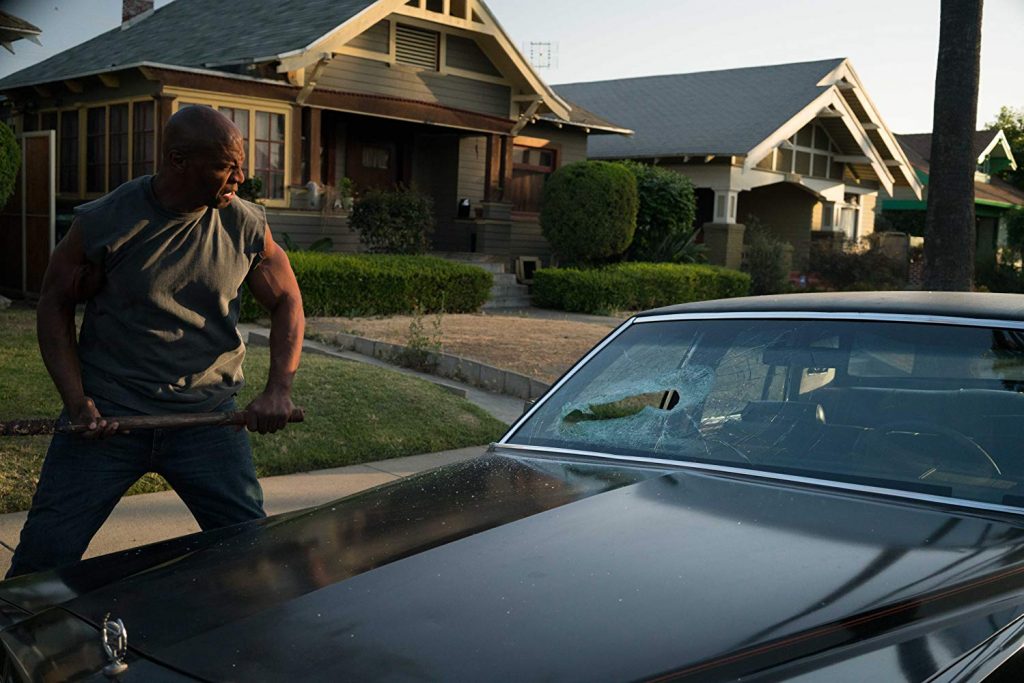January 24, 2020
by Carla Hay

Directed by Will Forbes
Culture Representation: Set in the Los Angeles suburb of Compton, this male-centric action drama’s cast of characters are almost all African Americans and Latinos from the lower and middle classes.
Culture Clash: The central conflicts are between gang members and the people they want to terrorize.
Culture Audience: “John Henry” is bottom-of-the-barrel blaxploitation that will appeal mostly to people who have a high tolerance for low-quality gangster flicks.

Before anyone thinks that the crime drama “John Henry” has anything to do with the story of the African American folk hero John Henry, the first 15 minutes of this laughably horrible film will make it clear that the name is just a gimmick. The John Henry in this film is played by Terry Crews, and the only thing this John Henry has in common with the folk hero is that he likes hammers. (He uses a sledgehammer as a weapon at one point in the movie.) There are no steel workers and no scenes of hard labor in “John Henry,” which takes place entirely in the crime-ridden area of Compton, the Los Angeles suburb made world-famous by rap group N.W.A.
And speaking of rap artists from the Los Angeles area, the entire “John Henry” movie (directed by Will Forbes, who co-wrote the screenplay with Doug Skinner) looks like it was made by people who get their stereotypical ideas of Compton’s African Americans from music videos that N.W.A. made in the ’80s and former N.W.A. member Dr. Dre made in the ’90s. (The only white people in this movie are cops, who are shown briefly after they respond to a shootout.) The movie’s attempt at hip-hop authenticity is to have a soundtrack of songs mostly by DJ Quik, who’s an executive producer of “John Henry.”
Crews has a larger-than-life personality in most of his on-screen roles, but his John Henry character in the movie is a slow-moving, slow-talking, brooding hulk of a man who’s awkward when he’s around other people. John has a generous side, but he isn’t afraid to get rough if necessary. John lives with his father, BJ Henry (played by Ken Foree), a foul-mouthed braggart who’s in a wheelchair and needs oxygen tubes to breathe. John, who’s supposed to be in his late 40s, doesn’t seem to be gainfully employed and he has no friends, so the movie makes it look like he and BJ are living off of BJ’s Social Security and disability payments from the government.
In fact, none of the black men shown in this movie seem to be making an honest living by having steady jobs. The “John Henry” filmmakers are basically fueling the worst racist stereotypes that black men who live in a predominantly black area are non-productive losers who are either criminals or on welfare. One of the reasons why John Singleton’s 1991 drama “Boyz N the Hood” is a well-written, Oscar-nominated classic is because it accurately showed the variety of African Americans who live in South Central Los Angeles (a predominantly black area), as ranging from law-abiding, hard-working citizens to destructive gang bangers.
The 2015 N.W.A. biopic “Straight Outta Compton” (another movie with an Oscar-nominated screenplay) also accurately depicted that not everyone who lives in Compton is poor or a criminal. For example, N.W.A. member Ice Cube came from a stable middle-class home with two married, hard-working parents. “John Henry” was obviously made by people who would never live in a predominantly black neighborhood. It seems like they’ve gotten their narrow, biased views of black people from movies, TV shows and music videos that perpetuate the negative stereotypes (especially about black men) instead of showing the diverse array of people who live in predominantly black areas. “John Henry” is another one of those lazy, ignorant movies that recycles the same bigoted clichés.
The movie shows flashbacks of John’s life as a teenager in the early 1990s, as seen through old home videos. Back then, BJ had high hopes for John, but John joined a gang with John’s cousin, who has the street name Hell. (Rich Morrow plays the young John. Maestro Harrell plays the young Hell, and Chris “Ludacris” Bridges plays the adult Hell.) At some point when John was still a young man, he decided to quit the gang and “thug life” altogether.
When John told Hell about his decision to leave the gang and stop committing crimes, Hell got angry, and the two guys got into a tussle that ended with John accidentally shooting Hell in the face. The gunshot wound left a scar that the adult Hell covers up with an embellished metal plate that looks like it was tossed off of the set of Michael Jackson’s “Remember the Time” video. The falling out between the two cousins has lasted for all these decades, and John has become Hell’s sworn enemy.
Meanwhile, Hell has risen through the ranks of the gangster world in Compton. He now heads a gang whose signature color is white. This movie is so over-the-top ridiculous that the gang members not only dress entirely in white, but they also wear similar sweatsuits. They don’t look like a menacing gang. They look like they’re about to go to work at a spa.
The gang members have street names such as Savage, Gram, Whack, Mookie, Midnight and Deyday. (All of them are men except for one butch-looking woman.) And when they talk, they say the “n” word every couple of minutes. Women are referred to as “bitches” and almost all of the women around them are involved in prostitution. But what’s really absurd is that while these thugs are talking in Ebonics, they sometimes throw in a few phrases such as “Orwellian rules” and “recidivism.”
It seems like the screenwriters want to pander to stereotypes of black criminals from the ‘hood being uneducated, but then mock them by making the thugs say words that they’re supposedly not smart enough to know. This satire technique would work well if the jokes were funny, but they’re not. The filmmakers show a lot of racial condescension by making all the black people in Compton look like a bunch of idiots, including the neighborhood extras who stand around and gawk on their front lawns while an outdoor shootout is happening nearby in broad daylight and they’re in the line of fire.
The Latinos in the movie are also depicted in negative clichés. Near the beginning of the film, members of the sweatsuit gang are sitting around playing poker and smoking weed when they’re ambushed in a home invasion shootout, where several people end up getting killed or injured. The two armed Latino men who’ve barged into the house are small-time drug dealer Emilio (Joseph Julian Soria) and his younger half-brother Oscar (played by Tyler Alvarez), who’ve come to rescue their sister Berta (played by Jamila Velazquez), who’s being held against her will as a prostitute. Berta and Oscar look like they’re in their late teens or early 20s, while Emilio seems to be in his late 20s.
During the melee, Oscar gets shot, while Emilio and Berta run out of the house. Emilio is detained by police, but Berta manages to escape, and she hides underneath John Henry’s front porch. John finds Berta and invites her inside, where he makes her a sandwich and tries to communicate with Berta to get her story, even though she doesn’t really know any English, and John can barely speak Spanish. Luckily, John’s father BJ can understand Spanish more than John can (how convenient), so he acts as a translator. Kind-hearted John offers Berta a place to stay until they can figure out what to do.
John gets somewhat of a love interest in the movie, when he goes to a local drugstore to buy some feminine products for Berta, who’s told him that she’s menstruating. (Yes, it’s that kind of movie.) While John is standing around, looking very confused in the aisle with tampons and sanitary pads, he’s spotted by one of the drugstore employees named Tasha (played by Kimberly Hebert Gregory), a former classmate of his from high school. Tasha is thrilled to see John again, and she obviously still has a crush on him. She gets even more excited when she finds out that, just like her, John is also single and doesn’t have any kids. But John, who’s preoccupied with his Berta problem, is oblivious to the love signals that Tasha is sending out, and just like a clueless schmuck, he leaves her hanging.
Somehow, Emilio shows up at the Henrys’ house to retrieve Berta, who’s afraid to leave. And why should she leave? While she’s hiding out, she’s getting free meals and lodging, courtesy of John Henry, and Emilio is going to be a target of the gang members who will be looking for her.
Emilio’s sudden appearance at the Henry house is one of many plot holes, because the movie doesn’t explain how Emilio found out that Berta was there. She obviously didn’t call Emilio, because she doesn’t want to leave with him. The movie also never explains what happened after Emilio was stopped by the police who caught him fleeing from the shootout. Adding to the muddled plot, there’s a lot of Spanish dialogue with no subtitles whatsoever.
It turns out that Berta and Oscar are undocumented immigrants who have fled Honduras because they were afraid of being killed by gang members. Oscar and Berta tracked down their half-brother Emilio because he’s the only family member they have in the United States. The three siblings weren’t reunited for very long and were walking down a street together when Berta was abducted by the sweatsuit gang members who were riding by in a van. Because of his involvement in drug dealing, Emilio managed to find out where Berta was being held, so he and Oscar planned the home invasion to break her out of the gang house.
Meanwhile, John’s cousin Hell (who doesn’t wear white, but wears his encrusted facial guard like he thinks he’s some kind of supervillain) wants revenge for the home invasion, and he sends his goons to find out who’s responsible and to get Berta back. It doesn’t take a genius to predict that there’s going to be a showdown between John and Hell.
But before that happens, much of the movie is bogged down with cringeworthy conversations and long silences, mainly because John Henry has such an “arrested development” personality. In other words, “John Henry” is far from a non-stop action movie. When the action does happen, a lot of it is unrealistic and unimaginative. And the movie even rips off a little bit of the first “John Wick” movie when John Henry’s beloved dog gets killed by a gangster in the opening scene, and there’s a shot of John Henry carrying the dead dog like John Wick did.
“John Henry” reaches the point of no return in stupidity when wheelchair-using, oxygen-tube-wearing BJ suddenly becomes a gun-toting action hero who can stand up and move around as if he never needed a wheelchair. As an explanation for his improbable physical transformation, BJ quips, “Adrenaline is a hell of a drug!” In another so-dumb-it’s-almost-funny scene, another character survives a bullet wound to the head that knocked him unconscious for quite some time, but then he was able to get up with all of his motor skills intact. And what’s one of the first things he does after experiencing this trauma? Get medical treatment? No. He shaves.
“John Henry,” for all of its flaws, would be a more watchable film if it at least delivered thrilling action. Instead, just like the title character, “John Henry” is a little too slow, empty-headed and predictable to make it worthwhile to see for some campy entertainment.
Saban Films released “John Henry” in select U.S. cinemas, digital and on VOD on January 24, 2020.
